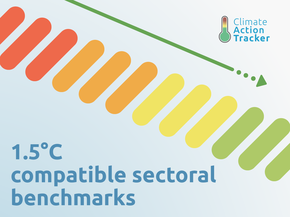Assumptions
Historical emissions
The historical emissions data was obtained from the Quarterly Update of Australia’s National Greenhouse Gas Inventory: September 2020 (DISER, 2021a). All emissions data is reported in financial years for Australia. Australia’s emissions inventory is recalculated regularly, see the Quarterly Update for details (DISER, 2021a). Recalculations of historical data can have repercussions for meeting the NDC target and on the starting point for projections data.
NDC and other targets
For the 2030 pledge, we have estimated levels of emissions excluding LULUCF resulting from the NDC by subtracting projected emissions for the LULUCF sector in 2030 from the targeted level including LULUCF.
Analysis of the effect of the NDC on likely fossil fuel and industrial GHG emissions is made difficult by the fact that the NDC target includes LULUCF emissions, which have been substantial in the past and fluctuate significantly (Figure 2 under “Data Sources and assumptions” in our Australia report of 2015). We have estimated levels of emissions excluding LULUCF resulting from the NDC by subtracting projected emissions for the LULUCF sector in 2030 from the targeted level including LULUCF. We estimate that the NDC translates into emissions level of 442-464 MtCO2e excluding LULUCF, equivalent to 5% to 8% above 1990 emissions level excluding LULUCF. In other words, because LULUCF emissions were substantial in 1990 (193 MtCO2e), but are projected to be a sink in 2030 (-1 to -11 MtCO2e), the NDC equates to either 27–29% below 1990 when one includes LULUCF or 5–8% above 1990 levels when one excludes it.
The conclusions of the present CAT assessment are subject to uncertainty as Australia regularly revises its emissions data. The government has repeatedly revised emissions projections downwards. This has typically not been backed by stronger climate policies but is rather the result of a change in assumptions. There have been significant recalculations of the LULUCF sector for 2030, from -1 MtCO2e in the 2018 government projections to -10 MtCO2e in 2019 to -5 MtCO2e in 2020 government projections. The decline in emissions was attributed to a continuation of the Climate Solutions Fund that has so far proven ineffective (formerly called Emissions Reduction Fund) (DEE, 2019a; Department of the Environment and Energy, 2018).
For a detailed description of LULUCF accounting rules used to calculate the Kyoto targets and 2020 pledge, please consult our Australia report.
Current policy projections
The policies and action projection range is based on the weaker recovery and stronger recovery scenarios published in Australia’s Emissions Projections 2020 report (Australian Government, 2020f). The projections data is harmonized to historical data. The CAT always provides policies and action projections excluding LULUCF. To this end, we subtracted the projections provided for LULUCF. Where LULUCF is included for comparison purposes, we use a range based on the maximum and minimum levels from the 2018, 2019 and 2020 government projections reports (Australian Government, 2020f; DEE, 2019a) The range is used given the high uncertainty of this sector and the large differences between government annual projections.
The weaker recovery and stronger recovery scenarios from the 2020 Australian Projections report are based on a baseline which accounts for emissions under current policy. The baseline projections include the following policies:
- Technology Investment Roadmap and Low Emissions Technology Statement
- Emissions Reductions Fund and the Climate Solutions Fund
- Large-scale Renewable Energy Target (expired in 2020) and the Small-scale Renewable Energy Scheme
- State and national energy efficiency measures
- National Energy Productivity Plan
- Initiatives by ARENA and CEFC
- Renewable energy targets of Queensland, Victoria, Tasmania and the Northern Territory
- State waste policy
- The National Food Waste Strategy
- Legislated phase-down of hydrofluorocarbons (HFCs)
- Energy Performance, refrigeration and air conditioning measures
The weaker and stronger recovery do not reflect further policy but differences in economic activity (Australian Government, 2020f). The CAT utilises these scenarios as a range to account for the unknown impact of COVID-19. The weaker recovery scenario assumes a low economic recovery delaying the return to pre-pandemic activity compare to the baseline. The stronger recovery scenario assumes a quick recovery and faster return to pre-pandemic activity levels compare to the baseline.
The high technology uptake scenario by government was not used, as it makes a number of assumptions not reflected in current policy, despite the government claiming it will beat its 2030 target under this scenario. It assumes “stretch” goals for each of the priorities areas in the low emissions Technology Statement to be economically competitive and replace current high emissions technology (Australian Government, 2020f). The priority areas are clean hydrogen, energy storage, low carbon materials (steel and aluminium) CCS and soil carbon. The scenario assumes renewables and battery storage costs decline faster than the baseline (Australian Government, 2020f). It assumes households update battery storage, and high levels of distributed energy management and a higher levels of renewable generation compared to the baseline (Australian Government, 2020f). It also assumes a low energy demand due to higher energy efficiency rates and renewable uptake internationally compared to the baseline (Australian Government, 2020f). These different international assumptions do not reflect a policies and action scenario.
Global warming potentials
The CAT uses Global Warming Potential (GWP) values from the IPCC's Fourth Assessment Report (AR4) for all its figures and time series. Assessments completed prior to December 2018 (COP24) used GWP values from the Second Assessment Report (SAR).
Further analysis
Latest publications
Stay informed
Subscribe to our newsletter





